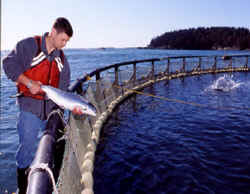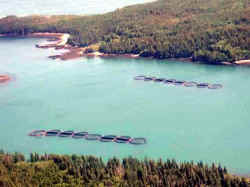Bibliography Background About KRIS
Aquaculture and Threats to Wild Gulf of Maine Atlantic Salmon
Potential impacts of Atlantic salmon aquaculture on wild salmon were recognized by the Maine Aquaculture Task Force (2004), in the listing notice for Gulf of Maine Atlantic salmon (USFWS and NOAA, 1999) and in the Atlantic Salmon Conservation Plan for Seven Maine Rivers (MASTF, 1997). Baum (1997) rated net pen rearing in Maine as the second most important threat to restoring wild Atlantic salmon populations after dams. There is no threat to Atlantic salmon perceived from shellfish related aquaculture, which also occurs along the coast of Maine (MATF, 2004). There are not Atlantic salmon aquaculture facilities in the Gulf of Maine near the Sheepscot River, but there is a steelhead aquaculture facility in Sheepscot Bay (Maine Department of Marine Resources, 2004)
 The joint Atlantic Salmon Federation and World Wildlife Fund recently released a report on international threats of aquaculture to wild Atlantic salmon (Porter, 2003). The report is aimed at tracking compliance with the 1994 Oslo Resolution signed by the seven member countries of the North Atlantic Salmon Conservation Organization (NASCO), which was a "convention for the conservation of salmon in the North Atlantic Ocean to minimize impacts from salmon aquaculture on wild stocks". Porter (2003) puts forth three major thrusts for protecting wild fish from negative interactions with farmed fish:
The joint Atlantic Salmon Federation and World Wildlife Fund recently released a report on international threats of aquaculture to wild Atlantic salmon (Porter, 2003). The report is aimed at tracking compliance with the 1994 Oslo Resolution signed by the seven member countries of the North Atlantic Salmon Conservation Organization (NASCO), which was a "convention for the conservation of salmon in the North Atlantic Ocean to minimize impacts from salmon aquaculture on wild stocks". Porter (2003) puts forth three major thrusts for protecting wild fish from negative interactions with farmed fish:
- Regulatory requirements for siting salmon aquaculture operations a safe distance from wild salmon rivers,
- Manage aquaculture to to prevent and control disease and parasites and their spread to wild fish, and
- Taking precautions to prevent escape of farmed fish to the wild.
The Maine Atlantic Salmon Task Force (MASTF, 1997) expressed concern about farmed salmon escaping to interbreed with wild salmon resulting in offspring of reduced fitness, since the broodstocks aquaculture broodstocks are often of European origin and not well adatped to Maine rivers. Large escapes of aquaculture Atlantic salmon have occurred off the coast of Nova Scotia very near some Maine DPS rivers (Porter, 2003), and Kircheis (2001) reported 62 adults of aquaculture origin in the Dennys River in 2001. In Maine, 90% of net pen rearing takes place in Downeast rivers within 30 miles of the Canadian border, which makes potential impacts greatest on the Dennys, East Machias, Machias, Pleasant and Narraguagus Rivers (MASTF, 1997). The Maine Aquaculture Task Force (MATF, 2004) did not make a recommendation for siting net pens away from Atlantic salmon DPS rivers, although it was noted as being requested in a minority report.
 "Potential threats to salmon may occur if farmed salmon transmit diseases or parasites to Atlantic salmon stocks within the seven rivers or within the nearshore marine environment when wild salmon migrate through marine waters adjacent to sea cages" (MASTF, 1997). Porter (2003) noted that: "Although farmed fish may be better adapted to higher year-round densities than wild fish, the stress of high densities causes fish to produce hormones that have been shown to suppress the animals immune system (Barton and Iwama, 1991). That potential impact in turn raises the risk of rapid disease transmission (Paone, 2000)." Areas under pens with high stocking densities have accumulations of fish waste, uneaten food and sometimes disease organisms that pose risk of infecting future generations of farmed fish and wild fish (Needham, 1995). To lessen this risk, Irish fisheries managers (DMNRI, 2000) have required fallowing of pen areas until disease organisms in the benthos are no longer present. Farmed fish are fed large amounts of antibiotics to suppress disease outbreak and resistant bacterial disease organisms have been found to breed under net pens as well (Husevag and Lunestad, 1991), although Sowles (2003) did not find evidence of this in Maine.
"Potential threats to salmon may occur if farmed salmon transmit diseases or parasites to Atlantic salmon stocks within the seven rivers or within the nearshore marine environment when wild salmon migrate through marine waters adjacent to sea cages" (MASTF, 1997). Porter (2003) noted that: "Although farmed fish may be better adapted to higher year-round densities than wild fish, the stress of high densities causes fish to produce hormones that have been shown to suppress the animals immune system (Barton and Iwama, 1991). That potential impact in turn raises the risk of rapid disease transmission (Paone, 2000)." Areas under pens with high stocking densities have accumulations of fish waste, uneaten food and sometimes disease organisms that pose risk of infecting future generations of farmed fish and wild fish (Needham, 1995). To lessen this risk, Irish fisheries managers (DMNRI, 2000) have required fallowing of pen areas until disease organisms in the benthos are no longer present. Farmed fish are fed large amounts of antibiotics to suppress disease outbreak and resistant bacterial disease organisms have been found to breed under net pens as well (Husevag and Lunestad, 1991), although Sowles (2003) did not find evidence of this in Maine.
Sowles (2003) noted that "nutrient enrichment of the water column from excretory products and waste feed has the potential to lead to oxygen depletion, ammonia toxicity and algae growth". Areas under pens in bays near Downeast rivers, however, did not show high nutrient build up according to Sowles (2003), likely due to the flushing power of the tides. Legal issues have been raised as to whether Maine's net pen rearing aquaculture facilities are in compliance with the federal Clean Water Act (MATF, 2004). Dill et al. (2002) state that the "EPA has assembled a task force to address wastewater discharge concerns and ultimately produce national discharge standards for all commercial and public aquaculture operations (EPA-821-F-00-002)." Monitoring of net pen sites for nutrients and potential for disease transmission is now a requirement of aquaculture permits in Ireland (DMNRI, 2000b)
Aquaculture in Maine has dropped from a high point in the mid-1990's when it grossed $75-80 million and created more than 1,000 jobs. As of 2004, the number of jobs had dropped to 330 and the gross worth of farmed salmon declined to $57 million (MATF, 2004). The decline was attributed by the Maine Aquaculture Task Force to disease outbreaks of salmon anemia (ISA) virus, extreme cold in 2002, increased mechanization of processing and a drop in market price for wholesale farmed salmon from $5 per pound to closer to $2 per pound (MATF, 2004). In its recently released final report: "the Task Force reaffirmed that there is the potential for negative impact on the environment, and that there needs to be a robust and efficient monitoring program to ensure that these impacts are limited and reversible." Specifically it recommended that studies be conducted on migration routes of wild salmon smolts and "pathways of exposure to assess risk from salmon farms" (MATF, 2004).
The listing notice for the Atlantic salmon Gulf of Maine DPS (USFWS and NOAA, 1999) recognized several aquaculture related impacts as a potential "take" of listed fish:
-
"The escapement of reproductively viable non-North American strain or non-North American hybrid Atlantic salmon from freshwater hatcheries within the DPS range;
-
The escapement from marine cages or freshwater hatcheries of domesticated salmon such that they are found entering or existing in rivers within the DPS range;
-
Failure to adopt and implement fish health practices that adequately protect against the introduction and spread of disease; and
-
Siting and/or operating aquaculture facilities in a manner that negatively impacts water quality and/or benthic habitat."
USFWS and NOAA (2000) concluded that: "Existing regulatory mechanisms are not sufficient to remove the threat posed by agricultural water withdrawals, disease, and aquaculture to the Gulf of Maine DPS of Atlantic salmon."
References
Barton, B.A. and G.K. Iwama. 1991. Physiological changes in fish from stress in aquaculture with and emphasis on the response and effects of Corticosteroids. Ann. Rev. Fish. Dis. 1: 3-26.
Baum, E. (1997). Maine Atlantic Salmon: A National Treasure. Hermon, ME:, Atlantic Salmon Unlimited. 224 p.
Department of the Marine and Natural Resources, Ireland. 2000. Protocol for Fallowing at Offshore Fin Fish Farms. DMNR, Dublin , Ireland .
Department of the Marine and Natural Resources, Ireland. 2000b. Monitoring Protocol No. 1 for Offshore Finfish Farms- Benthic Monitoring. DMNR, Dublin , Ireland.
Dill, R., C. Fay, M. Gallagher, D. Kircheis, S. Mierzykowski, M. Whiting, and T. Haines, 2002. Water quality issues as potential limiting factors affecting juvenile Atlantic salmon life stages in Maine rivers. Report to Maine Atlantic Salmon Technical Advisory Committee by the Ad Hoc Committee on Water Quality. Atlantic Salmon Commission. Bangor, ME. 28 pp. [162kb]
Husevag, B. and B.T. Lunestad. 1991. Simultaneous occurrence of Vibrio salmonicida and antibiotic resistant bacteria in sediments at abandoned aquaculture sites. J. Fish Dis. 14: 631-640.
Kircheis, F.W., 2001. Annual Report to the Maine Legislature Fish and Wildlife Committee for the period January through December 2001. Maine Atlantic Salmon Commission, August, Maine. 59 pp. [1.4 Mb]
Laser, Melissa. Personal communication. Atlantic Salmon Comission, Bangor Maine.
Maine Department of Marine Resources, 2004. Aquaculture Lease Inventory Augusta, ME. Accessible online at http://www.maine.gov/dmr/aquaculture/aqualeaseinventory.htm
Paone, S. 2000. Industrial Disease: The Risk of Disease Transfer from Farmed Salmon to Wild Salmon. Friends of Clayquot Sound, Tofino, B.C.
Porter, G. 2003. Protecting Wild Atlantic Salmon from the Impacts of Salmon Aquaculture: A Country by Country Progress Report. Published jointly by the World Wildlife Fund and the Atlantic Salmon Federation 74 pp. [1.85Mb]
Maine Aquaculture Task Force. 2004. Governor’s Task Force on the Planning and Development of Marine Aquaculture in Maine Report and Recommendations. State of Maine, Augusta. 192 p. [550kb]
Maine Atlantic Salmon Task Force. 1997. Atlantic Conservation Plan for Seven Maine Rivers. Task Force Appointed by the Governor of Maine. 353 p. [1.6Mb]
Sowles, J.W. 2003. Water Quality and Benthic Impacts of Marine Aquaculture in Maine. Maine Department of Marine Resources, Ecology Division. Report to the Maine Aquaculture Task Force. 7 p. http://www.penbay.org/aqwaterqualsowles03.html
USFWS and NOAA. 2000. Endangered and Threatened Species; Final Endangered Status for a Distinct Population Segment of Anadromous Atlantic Salmon (Salmo salar) in the Gulf of Maine. Federal Register Notice Vol. 65, No. 223 / Friday, November 17, 2000 / Rules and Regulations. Pages 69459-69483.[225 kb]
